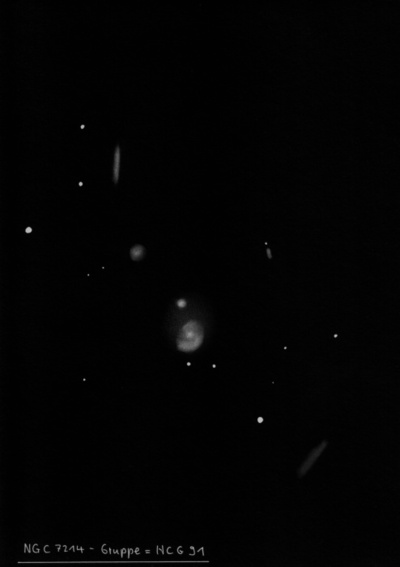A small constellation in the southern sky that we would hardly notice if it were not for Fomalhaut, the main blue-white star of the first magnitude. The other stars are faint, and because the Southern Pisces lies further from the Milky Way, it is not rich in objects other than galaxies. In addition, their southern location makes clear clear nights and a dark horizon in the south an absolute necessity to observe them from virtually any observing position in Europe.
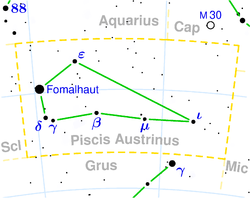
Fomalhaut (α PsA) - It lies on the extended line connecting the stars Schema-Markab in the constellation Pegasus. With its brightness of 1.2 mag, the yellow-white Fomalhaut is only 25 light-years away and is among the 20 brightest stars in the sky. Compared to the Sun, it is more than twice the diameter and its luminosity exceeds our star by 16 times.
ε PsA - The companions have a brightness of 5.5mag and 6.5mag, with a separation of 1.6". We need a telescope with an objective diameter above 100 mm.
Fum al Samakah (β PsA) - Optical double star distinguishable with a good refractor. The primary white component of this pair has a brightness of 4.4mag and the blue companion at a separation of 30.3" reaches a magnitude of 7.9mag.
γ PsA - Stars with magnitudes 4.5 and 8.1 have a separation of 4.3". To resolve them, we need a 100 mm telescope, mainly due to the difference in brightness of both components. They are located at a distance of 215 light-years.
η PsA - In a 200 mm telescope, this binary system appears as two blue-white disks almost in contact. The components have magnitudes of 5.8 and 6.8 and are separated by 1.7".
Lacaille 9352 - The red dwarf has a visual magnitude of 7.4. After Barnard's Star and Kapteyn's Star, and after Groombridge 1830 from Ursa Major, Lacaille 9352 exhibits the fourth fastest known proper motion. This star will move by 6.9" per year, and by the year 2100, it will already be located in the neighboring constellation of Sculptor. It is situated at a distance of only 10.7 light-years.
NGC 7135
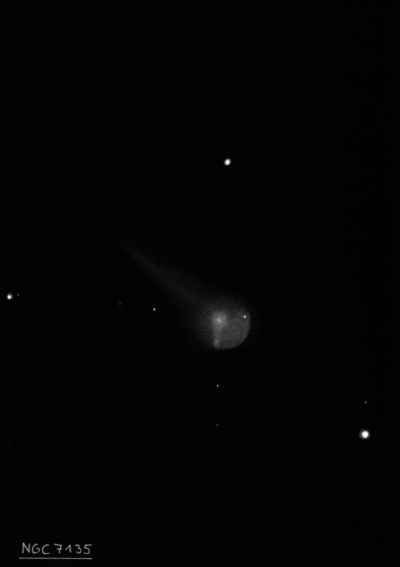
John Herschel discovered NGC 7135 = h3891 on 23 Sep 1834 and recorded "pB; R; bM; 20"; a * 14m precedes just out of neb." On the next sweep he logged "pB; L; vgbM; has 5 st 8m in field surrounding it [the stars are 9th-11th mag]."
Lewis Swift found the galaxy again on 17 Sep 1897 at age 77 near the end of his observing career and assumed it was new. His description of Sw. XI-209 reads "eeF; pL; R; 3 B st form a triangle; nf of 2 [with IC 5135 = NGC 7130]." Herbert Howe reexamined the field in 1899 and realized Swift's #209 was identical to NGC 7135, so Dreyer didn't assign an IC desigation. But IC 5136, also from Swift just 2 nights earlier, may be another observation of NGC 7135. See Corwin's identification notes for that story.
300/350mm - 13" (8/5/83): faint, small, round, similar to NGC 7130 19' WSW. A triangle of stars precedes the galaxy.
400/500mm - 17.5" (8/6/97): moderately bright, moderately large, ~2' diameter, irregularly shaped bright core. The halo appears to have an uneven or mottled surface brightness. A mag 14-15 star is embedded at the west edge [34" from center]. Located just following a bright triangle of mag 9.5-10.5 stars. NGC 7130 lies 19' WSW.
17.5" (7/16/93): fairly faint, fairly small, round, broad weak concentration, small bright core. Follows an isosceles triangle of mag 9.5-10.5 stars including mag 9.4 SAO 213316 5' NW, a mag 10 star 3.3' SW and a mag 11 star 2' N. Third of three with NGC 7130 19' WSW.
17.5" (7/30/92): fairly faint, fairly small, round, broad mild concentration. Unusual as three stars mag 9-10 just west form a right triangle. The galaxy is just east of a line connecting the two stars on the east side of the triangle.
Notes by Steve Gottlieb
NGC 7221
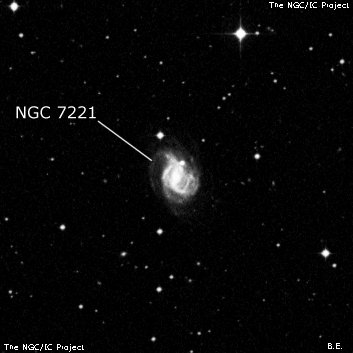
John Herschel discovered NGC 7221 = h3928 on 27 Sep 1834 and recorded "F; R; gbM; has 2 stars 14m near; one almost involved." His mean position (measured on 4 sweeps) is good.
400/500mm - 17.5" (10/5/91): faint, fairly small, elongated 4:3 N-S, gradually brightens. A mag 13.5 star is just off the NE edge 1.3' from center.
Notes by Steve Gottlieb
NGC 7214
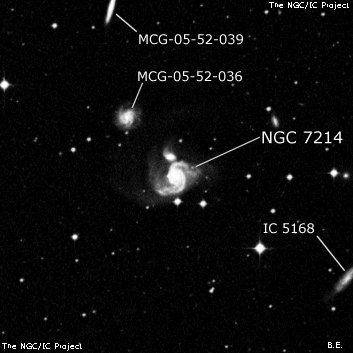
John Herschel discovered NGC 7214 = h3926 on 30 Jul 1834 and recorded "a vS cluster or resolvable nebula; irreg R; lbM; 2' diam; has 2 or 3 stars larger than the rest." His position is accurate. Herbert Howe, observing with the 20" refractor in Denver in 1898-99, remarked "h calls this a globular cluster. To me it appeared to be a nebula having a nuclear condensation of mag 12; the surrounding nebulosity was indefinite in extent."I
In 1915 Knox-Shaw reported it was a not a globular cluster, but an open spiral, based on a photograph taken between 1912-13 the Helwan Observatory with the Reynolds reflector. Based on imges taken 1914-16 it was described as "spiral with two arms, lE 90°, vB stellar nucleus with faint star following 15"."
400/500mm - 17.5" (10/13/90): fairly faint, very small, slightly elongated, very small very bright core, a mag 13 star is just off the SW end, 1.1' from center. This galaxy is the brightest of four in HCG 91. An almost stellar companion, MCG -05-52-035 = HCG 91D, is 30" NNE, MCG -05-52-036 = HCG 91C 2.2' NE and MCG -05-52-039 = HCG 91B 5' NNE.
600/800mm - 24" (9/6/18): NGC 7214 is the dominant member of the HCG 91 quartet. It appeared moderately bright, moderately large, ~50" diameter, well concentrated with a well-defined bright core that increased to the center and a fainter, slightly irregular halo (no spiral structure, though). HCG 91D is barely off the north edge and appeared fairly faint, very small, round, ~0.3' diameter, very small brighter nucleus with a stellar peak.
ESO 467-011 (misidentified as IC 5168), located 5.6' SW of NGC 7214, was a threshold object and popped a couple of times at 220x as a thin edge-on, ~5:1 NW-SE. A number of faint ESO galaxies surround HCG 91, including ESO 467-17 21' ESE, ESO 467-16 19' NNE, ESO 467-5 36' WSW.
Notes by Steve Gottlieb
NGC 7174
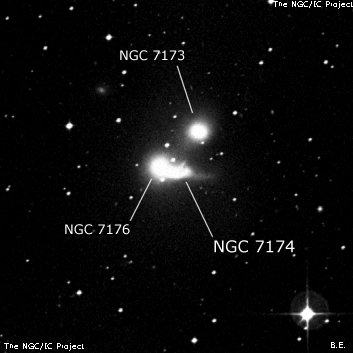
John Herschel discovered NGC 7174 = h3910 on 28 Sep 1834 and recorded "in sweep 493 this was taken for a vF star, but I now perceive it plainly to a small faint round nebula." His position and sketch matches ESO 466-040 = HCG 90D.
The RNGC reverses the identifications of NGC 7173 and 7174, making NGC 7173 and 7176 the contact pair. This misidentification is listed in my RNGC Corrections #1.
300/350mm - 13.1" (7/27/84): fairly faint, small. Virtually in contact with NGC 7176 on the NE edge 26" separation. In a compact trio with NGC 7173 1.3' NW in the NGC 7172 group. The identifications of NGC 7173 and NGC 7174 are reversed in the RNGC.
400/500mm - 18" (10/21/06): this is the western component of an interacting system with NGC 7176 attached to the east side. At 225x appears fairly faint, fairly small, elongated 5:2 E-W, 1.0'x0.4, very weak concentration, no noticeable core.
18" (9/3/05): fairly faint, fairly small, very elongated 3:1 E-W, 0.9'x0.3'. This member of the HCG 90 quartet is attached at the west edge of NGC 7176 and extends due west. The identifications of NGC 7173 and NGC 7174 are reversed in the RNGC.
600/800mm - 24" (8/23/14): at 375x, NGC 7174 was elongated perhaps 3:1 E-W, 0.9'x0.3'. The surface brightness is irregular with no core region. The galaxy appears to taper and brighten at the west end with a bend or short kink angling northwest. The east end merges into the halo of NGC 7176 on the its southwest end!
Notes by Steve Gottlieb
IC 5262
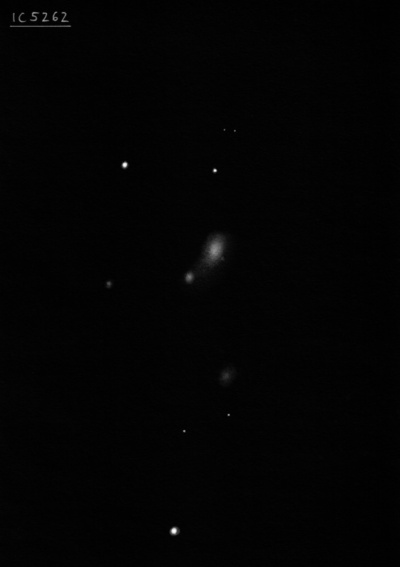
Lewis Swift discovered IC 5262 = Sw. XII-42 on 22 Aug 1897 and logged "eeeF, pS, R, bet a * p and a wide D nf, 8m * f, ee dif, np of 2." Although Swift calls this off the "north-preceding of 2" there is no listing in his table to the southeast of IC 5262 and Corwin suggests Swift may be referring to IC 5271, which is northeast.
400/500mm - 17.5" (8/6/97): fairly faint, fairly small, elongated 4:3 N-S, 0.9'x0.7'. A mag 12 star lies 1.4' N and a mag 11 star 1.9' NE. This is a double system with PGC 70010 but the southeast component was not seen. Also MCG -06-50-011 2' S was not seen.
Notes by Steve Gottlieb
HCG 90
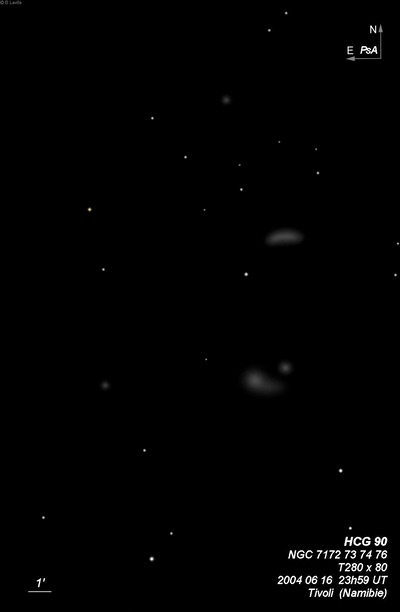
| Type | GALCL [E3] |
| RA | 22:02:05.6 |
| Dec | -31:58:00.0 |
| major_axis | 9.6' |
| mag | 9.1 |
| surface_bright | 99.9 |
